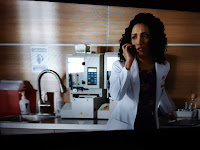Words are powerful. When well-chosen, their power magnifies;
when used inappropriately, they can metastasize into something quite damning to
a conversation… or a document… or social media.
Which is why every time I see Shaun and Lea’s
relationship described as “toxic,” I’m reminded of the often-quoted Mandy
Patinkin-as-Inigo Montoya line from The Princess Bride: “You keep using
that word… I do not think it means what you think it means.”
(Quick tip here: Before you seek out Princess Bride memes or GIFs for your next showdown with a Lea-hater, note that the Lea-haters I've witnessed are utterly uninterested in learning about Shaun and Lea's unique characteristics. Consider not engaging with them instead. Seriously. One log won't burn. Off my soapbox I go...)
I tend to think those of us who have been in and/or
witnessed a true toxic relationship-- rather than just heard the term batted
about in a pop psychology article or two—know at least some of the earmarks like
the back of their hand:
·
Lack of support
·
Poor communication
·
Disrespect
·
Controlling behavior
·
Resentment
·
Dishonesty
They also know any and all of the above is more than an argument, or even a recurring argument. Rather, they are deeply entrenched behaviors and actions that turn a relationship “toxic” over time. In other words… one angry exchange on a bridge + one alcohol-fueled verbal rant accompanied with a baseball bat does not a toxic relationship make. By definition alone, it simply DOESN'T.
But here’s the catch: when one of the two people in a
relationship has ASD, the potential for toxicity is significant. The
action may not be deliberate, particularly in the case of the one with ASD. But
the possibility remains very real.
It’s the big picture that we must keep in mind—the one
that includes the agonizing #Shea scenes alongside their big finale moment and
other greatest hits. The presumption is that Shaun and Lea will grow and mature
as their love story develops from here. Autism will continue to light the stage
they’re on, though. What vision of love on the spectrum* will TGD viewers
ultimately see?
(*Love on the Spectrum, by the way, also happens
to be the name of a 5-part Australian series about young adults with ASD and
their efforts to make romantic connections. It’s currently available on Netflix,
and quite interesting… check it out if you can!)
--
This storyline dives deep into darkness. Now, considering this—why is it that so many in social media have lashed out at Lea for rejection, but excuse Shaun’s misconduct? Because they want their heroes to be all good? Should autism be told as fairytale?
– from Andreas’ Reddit A Flawed Hero: The Darkness of Murphy MD
I first included Andreas (@AndreasAachen on Twitter, with the awesome, TGD-cribbed
tag line Autistic, not blind in his bio) and his lines about autism
being told as fairytale when I wrote about the baseball bat scene. And
his words stuck with me as I compiled info for this post. Part of the reason
for that is something else I learned of via Andreas: Tony Attwood’s book The
Complete Guide to Asperger’s Syndrome. Andreas tells me Attwood is a
leading authority on the subject, so I took a particular interest in Chapter
13, simply titled “Long Term Relationships.”
A QUICK TERMINOLOGY NOTE: As I understand it, “Asperger’s Syndrome” is
becoming an outdated term for high-functioning autism. In fact, the revised
editions of Attwood’s book are now called The Complete
Guide to Asperger's Syndrome (Autism Spectrum Disorder), as
ASD is becoming the preferred terminology. TGD hasn’t used “Asperger’s”
in any of its three seasons; for accuracy and consistency’s sake, I won’t
either.
Here are the points of interest in Attwood’s Chapter 13 that stood out the
most for me:
·
“Many women describe their first impression
of their partner… as someone who is kind, attentive and slightly immature… speaks
his mind… has strong moral convictions (with emphasis on “kind” and “speaks
his mind”, you’ve got Lea)… The partner with ASD is usually a late developer
in terms of emotional and relationship maturity.” (sounds like Shaun)
·
“Men with ASD tend to seek a partner who can
compensate for their difficulties in daily life – that is, someone from the
other end of the continuum of social and emotional abilities.” (while I don’t
think this is a description match for Shaun, I do see Lea in an “other end of
the continuum” way where he’s concerned. Elsewhere in the text it makes
reference to ASD men seeking partners with “advanced social and maternal
abilities”; I see that more in Carly than I do in Lea. For whatever that’s worth.)
·
In a sub-division of Chapter 13 entitled “Problems
in the Relationship”, Attwood discusses how the ASD/NT (short for Neurotypical)
courtship is often quite different than the subsequent marriage in that the ASD
partner can acquire “a superficial expertise” in the dating phase that they see
unnecessary to continue doing once a certain goal (marriage) is obtained. (I’d
argue that plenty of NT partners ALSO become something of a different person
once married! But I digress…)
What’s interesting about Shaun and Lea in this
scenario is that they’ve almost done this backwards: gotten to know how to live
together first (with no real romantic goals in mind), then witnessed how each
other functions in romantic relationships (with other people), and THEN, after getting
all the initial fears and frustrations out in the open, headed for the “courtship”
part of the journey. I’ve got to believe this is the sort of relationship “progression”
that will work in their favor, at least for now.
· But one big thing that gets reiterated in the
Attwood text is the sense of loneliness that the NT partner feels increasingly in
the relationship… through no real fault of the ASD partner, of course: “The
initial optimism that the partner with ASD will gradually change and become
more emotionally mature and socially skilled can dissolve into despair that
social skills are static due to limited motivation to be more sociable. This
can be due to the intellectual effort needed to socialize, subsequent
exhaustion, and a fear of making a social mistake.”
Although Shaun has so far proven amenable to a number of social situations—especially when he’s with friends—this could definitely become a sticking point in their relationship if the writers choose to venture down that road. Will Lea seek “going-out time” with Shaun as much as he is likely to seek “staying-in time”? How adversely will it affect him if she puts any pressure on the issue? How adversely will it affect her when multiple nights “staying in” lead to him researching the Case of the Week while she grudgingly cracks open her laptop in silence (because, with an autistic partner, this counts as spending quality time together)?
In other words… you know that early sense of Love
will make everything work out that can be felt in the early tremors of
troubled relationships? Well, Lea could be deep into that vibe as Season 4
begins, with the “trouble” in this case being those underlying concerns she
spelled out late in Season 3. What if she finds that Shaun simply cannot handle
her (self-proclaimed) selfish, needy ways over time? How would such
disappointment manifest itself in her case?
·
Speaking of the neediness issue: “A metaphor
for the need and capacity for affection can be that typical people have a
bucket that needs to be filled, whereas people with ASD have a cup that is
quickly filled to capacity. The person with ASD may not express sufficient
affection to meet the needs of his or her partner. However, I have known of
relationships where the partner with ASD expresses affection too frequently… As
a man with ASD said: ‘We feel and show affection but not enough and at the
wrong intensity.’”
One of the things #Shea ‘shippers love to crow
about is how much more Shaun and Lea have (already) clicked physically compared
to Shaun and Carly. So while it’s hard to imagine a time when their physical
affection quotas could be wildly out of sync… get ready. It’s quite possible.
·
And see if this passage reminds you of anything we’ve
brought up this summer: “During times of personal distress, when empathy and
words and gestures of affection would be expected as an emotional restorative,
the typical partner may be left alone to ‘get over it’. I have noted that this
is not a callous act; the partner with ASD is probably very kind, but in his or
her mind, the most effective emotional restorative is solitude.”
Cue whatever episodes are to come that present Lea
struggling with something, and Shaun struggling to understand why his response
(or lack thereof) is making things worse, not better. Think “you never once
asked what happened in Hershey…” times 15.
·
To understand this challenge even better: “Being
alone is often the main emotional recovery mechanism for people with ASD, and
they may assume that is also the case for their partner… I observed a
situation where a husband with ASD was sitting next to his wife, who was in
tears. He remained still and did not offer any words or gestures of affection.
Later, when I discussed this situation with him, and asked if he noticed that
his wife was crying, he replied, ‘Yes, but I didn’t want to do the wrong
thing.’”
Remember when Shaun realized Lea was crying in the “Hubert” episode, and after she explained why, it looked like he was about to reach out and comfort her… but instead, he reached for the fishbowl and left the apartment? I can almost see the ShaunVision® working to prevent him from doing “the wrong thing”, especially since the platonic boundaries of their relationship had been freshly established. Could he touch her hand? Sit closer? Offer a hug? No, she’s not my girlfriend. And I don’t do those things well anyway. What COULD he do? Be a doctor, and do it as soon as possible. Which is exactly what he did—and in this particular case, it made him Lea’s hero.
·
Before all that went down in the “Hubert”
episode, we often look to the post-pet shop scene of Lea gazing directly at
their new fish while Shaun sits across the room, finding great satisfaction in
reading aloud the water conditioning needs of Hubert’s bowl. “Daddy just
expresses his love in a different way,” Lea assured the fish. As most of us
have already pointed out from time to time, that line (that whole mini-storyline,
really) was a brilliant microcosm of Shaun and Lea’s particular ASD/NT dynamic
in action. And Attwood’s words confirm it: “The person with ASD may express
his or her love in more practical terms… (they) have difficulties with the
communication of emotions, and this includes love. When a partner said to her
husband with ASD ‘You never show you care,’ he replied, ‘Well, I fixed the
fence, didn’t I?’”
So if at this point you’re somewhere between Damn, did Lea read this
Attwood book already? She’s already pegged the danger zones so well… and Good
God, is there ANY hope to be had for ASD/NT couples? I feel you.
In fact, Attwood proposes three steps to get such faltering couples on the
right track: 1) both partners need to acknowledge the ASD diagnosis of the
affected partner (more on this in a minute), 2) both partners need to be
motivated to be able to change and learn, and 3) both partners need access to
relationship counseling, “modified to accommodate the profile of abilities
of the partner with ASD, and a willingness to implement suggestions from
specialists in ASD, the relevant literature and support groups.”
I know it’s a lot, and I, too, hope Shaun and Lea get a grace period of (mostly)
joy before the challenges start a-flying their way. But they already love each
other, so we know that element of the “courtship” is completed. And TGD has already
laid the groundwork (via previous difficulties) to test their relationship. We
know the storms are coming. We see, via writings such as Attwood’s, that Shaun
and Lea’s challenges are well-aligned with reality.
So we’re brought back around to Andreas’ question: Should autism be shown
as fairy tale?
You know who that decision will ultimately be left to? The TGD writers.
Not the producers in general; not David Shore in specific (unless he’s the one
writing a given #Shea episode). Just the writers; the very folks who came up
with “I don’t care.. but I care that YOU care”… and the story of Hubert… and all
the highs and lows that brought Shaun to say “Lea makes me MORE.”
How often they want to #Shea to reflect typical ASD/NT love stories… and how
often they give Shaun just the right words to save a situation… it’s entirely
their call.
Because words are powerful.
(NOTE: I said I'd be getting back to the part about both partners accepting an ASD diagnosis... I was referring to another article on the subject that I planned to touch on here, but didn't... I will get a link to it in the comments at some point. Lots to talk about here; not always lots of time to write!)
(I will likely do more posts on this specific topic in the future.)




































